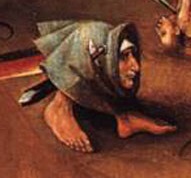Detail from the bottom of the central panel of Bosch’s Last Judgment in Vienna.
In my previous post[1] I mistakenly claimed that bodyhead is the term for what we Dutch-language speakers call koppoter or kopvoeter.
In reality, the term bodyhead was coined by English artist Paul Rumsey in the late 20th and early 21st century as titles to his own Two Bodyheads. A quick search in Google Books confirms this.[2]
Paul pointed me to the gryllus, a creature similar to gastrocephalic creatures (belly faces), to blemmyae and to his own bodyheads.
Gryllus, a term new to me, appears to be an interesting word, leading me to the discovery of the rudimentary taxonomy of hybrid creatures of the title of this post.
How so, you ask?
Here we go:
Gryllus (plural grylli) means pig in Greek and cricket in Latin. (Marina Warner, Monsters of Our Own Making).
In Plutarch’s Moralia, Gryllus was one of Circe’s victims who preferred to stay a pig after his transformation. This episode is known as “Ulysses and Gryllus“. Innumerable writers have commented on this episode, see “reasoning beasts”.
Another ancient writer who mentions grylli is Pliny the Elder in his Natural History. His concern is visual, i.e. painting. He uses the word gryllus for a class of grotesque figures first used in painting by Antiphilus of Alexandria: “he painted a figure in a ridiculous costume, known jocosely as the Gryllus; and hence it is that pictures of this class are generally known as “Grylli.”
The history of the grylli has received its most in-depth study in Marina Warner’s Monsters of Our Own Making. Most sources agree that the current meaning of the gryllus derives from Le moyen âge fantastique (1955) by Jurgis Baltrusaitis.[3]
The book Images, Texts, and Marginalia in a “Vows of the Peacock” by Domenic Leo gives a taxonomic vocabulary of hybrids in which the gryllus is one element:
- “I am using terminology proposed by Sandler, “Reflections on the Construction of Hybrids,” and Jurgis Baltrušaitis, Le moyen âge fantastique. The rudimentary taxonomic vocabulary for hybrids is as follows: bifurcated (head as center with two bodies), gryllus (body with no torso: head replaces genitals), pushmepullu (one body with a head emerging from each side), and composite (hybrids created from multiple parts).”
There is also this excellent Spanish-language page on grotesque grylli.[4].




